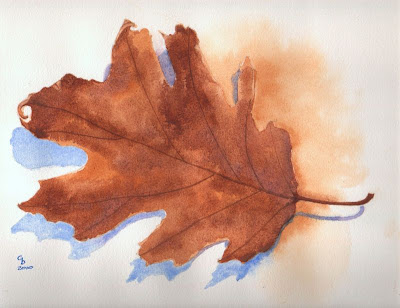 |
| From Ron Hazell's "A Summer Morning" - Watercolour on paper, 9" x 12" |
So I hope that if Mr. Hazell ever sees this, that he will feel flattered, and not accuse me of copyright infringement!
I chose this painting because I loved the colours, and because it contained some puddles and Mr. Hazell is a master at painting them. (I discovered my passion for puddles when I lived in San Miguel de Allende, Mexico, where my favourite painter, Dan Rueffert, was rather famous for putting puddles in most of his paintings. I googled him today and found that he's very much alive and painting, but not so many puddles any more. Click here if you want to see one of his recent puddles.)
I admire Ron Hazell very much. I'm glad he lives only a few hours away, in Halifax, because I hope to take one of his workshops next spring.
A few weeks ago, I purchased one of his DVDs; I'm sure that watching it helped me paint this copy though I resisted the temptation to put it on while I was doing the actual painting.
It's not a perfect copy -- it wasn't meant to be, but what I like about it is that I was able to capture the light, the strong light that appears to emerge from the street between the first and second buildings on the left and to flood the sidewalk and the big gateposts on the right, and to bleach out the leaves of the big tree.
I also like how the blue buildings fade out gradually, creating the necessary depth.
My puddles are only so-so, while Ron Hazell's are little works of art in themselves.
I should have reviewed his puddle demonstration before painting them!













